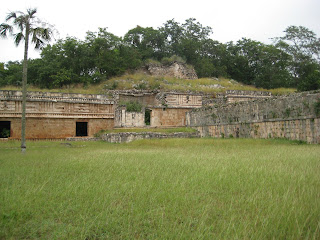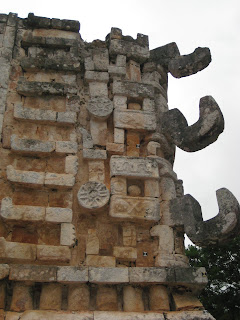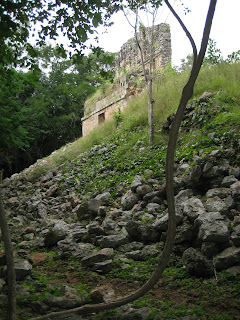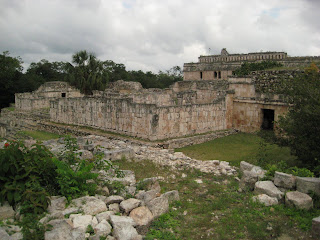




 I really love this first image of the man coming out of a feathered serpent's jaws. I believe it symbolizes the connection of one of Labna's rulers with Kukulcan, the feathered serpent venerated all over Mesoamerica, at different times and by different peoples/cultures. I have also posted pictures of the arch of Labna, which is a portal vault which served as a passageway (perhaps) between the residential areas of Labna (the elite residential areas) and the business or administrative areas of Labna. Also, the rather large structure known as El Mirador is what John Lloyd Stephens called "the most curious and extraordinary structure" that he had seen in his many travels around the Maya world. It does have a rather impressive roofcomb (that architectural structure reaching to the sky). Labna was a great way to start out our day of the Puuc route!!
I really love this first image of the man coming out of a feathered serpent's jaws. I believe it symbolizes the connection of one of Labna's rulers with Kukulcan, the feathered serpent venerated all over Mesoamerica, at different times and by different peoples/cultures. I have also posted pictures of the arch of Labna, which is a portal vault which served as a passageway (perhaps) between the residential areas of Labna (the elite residential areas) and the business or administrative areas of Labna. Also, the rather large structure known as El Mirador is what John Lloyd Stephens called "the most curious and extraordinary structure" that he had seen in his many travels around the Maya world. It does have a rather impressive roofcomb (that architectural structure reaching to the sky). Labna was a great way to start out our day of the Puuc route!!



 This is the site of Xlapak. No, literally, this one structure is Xlapak (pronounced Shlahpaac). We spent like 15 minutes taking pictures of this one structure but there is absolutely nothing else here! But this building is quite interesting, given all of the references to Chac, the Maya rain god.
This is the site of Xlapak. No, literally, this one structure is Xlapak (pronounced Shlahpaac). We spent like 15 minutes taking pictures of this one structure but there is absolutely nothing else here! But this building is quite interesting, given all of the references to Chac, the Maya rain god.


 And here I am at Sayil!! I couldn't wait to see this Palace up close. It's always so interesting to me to be able to come and visit many of the sites that have been mentioned in my classes! Although my learning about the ancient cultures of Mesoamerica has just begun, I feel like with every site that I visit, I'm able to extend the learning from the classroom to the actual ancient world of these various cultures. Sayil is believed to have been settled between the 2nd and 3rd centuries of the common era although most of its structures were built between the 8th century and the middle of the 10th. Here is the Great Palace (or the Palacio Norte). This palace contains more than 90 rooms and may have housed up to 350 people. Although the palace appears to be three levels, really each level is supported by a core of piled stone, as opposed to the story below it-it's an example of how Maya architects were accomplished illusionists. There are "diving gods" over the doorways (which are found also at the sites of Coba and Tulum-these gods may represent the god of Maize, maybe not). And of course, Chac masks are found on the sides of the palace. I really enjoyed seeing this great palace!!
And here I am at Sayil!! I couldn't wait to see this Palace up close. It's always so interesting to me to be able to come and visit many of the sites that have been mentioned in my classes! Although my learning about the ancient cultures of Mesoamerica has just begun, I feel like with every site that I visit, I'm able to extend the learning from the classroom to the actual ancient world of these various cultures. Sayil is believed to have been settled between the 2nd and 3rd centuries of the common era although most of its structures were built between the 8th century and the middle of the 10th. Here is the Great Palace (or the Palacio Norte). This palace contains more than 90 rooms and may have housed up to 350 people. Although the palace appears to be three levels, really each level is supported by a core of piled stone, as opposed to the story below it-it's an example of how Maya architects were accomplished illusionists. There are "diving gods" over the doorways (which are found also at the sites of Coba and Tulum-these gods may represent the god of Maize, maybe not). And of course, Chac masks are found on the sides of the palace. I really enjoyed seeing this great palace!!



 I wanted to include a picture of the dense forest path that one needs to walk down in order to see this next structure called El Mirador (the lookout). It hasn't been completely restored but it's interesting to see. I've also posted a few pictures of this building that has sunk into the ground. This particular structure has glyphs around the edges of only one of its doorways which I found interesting. Sayil is really another fascinating Puuc site.
I wanted to include a picture of the dense forest path that one needs to walk down in order to see this next structure called El Mirador (the lookout). It hasn't been completely restored but it's interesting to see. I've also posted a few pictures of this building that has sunk into the ground. This particular structure has glyphs around the edges of only one of its doorways which I found interesting. Sayil is really another fascinating Puuc site.



 Evidence from Kabah shows that a settlement was established here between 600BCE and 300BCE. It truly is a very interesting site and I'm glad that we were able to visit Kabah. Kabah, Sayil, and Labna form a line about 20km (or 12 miles) long and about 20km south of Uxmal. The visible architecture from these three sites dates to about 800CE-1000CE. I've included a picture of the main palace and its courtyard. We were only given a half-hour at each of these sites so I don't have a lot of information about them but here at Kabah, one can see many of the Puuc characteristics such as the columns, the Chac masks, the "mat" design (which signifies royalty and the power to govern), and the same type of architecture. I really loved being here!!
Evidence from Kabah shows that a settlement was established here between 600BCE and 300BCE. It truly is a very interesting site and I'm glad that we were able to visit Kabah. Kabah, Sayil, and Labna form a line about 20km (or 12 miles) long and about 20km south of Uxmal. The visible architecture from these three sites dates to about 800CE-1000CE. I've included a picture of the main palace and its courtyard. We were only given a half-hour at each of these sites so I don't have a lot of information about them but here at Kabah, one can see many of the Puuc characteristics such as the columns, the Chac masks, the "mat" design (which signifies royalty and the power to govern), and the same type of architecture. I really loved being here!!



 Here is the Codz Poop (pronounced "pope") building at Kabah which has these two rather large figures on one side and about 250 Chac masks on the other side!! It is such an impressive building and truly worth the stop (even if we were only given a half-hour at this site). The final picture I took from the entrance in order to show a long walk in the grass before we got to the Palace. I absolutely loved being able to come to these Puuc sites and marvel at all of the constructive innovations and artistic details left by the ancient Maya in this particular region. What a great experience this was, seeing 5 different Puuc sites in my very first day in Yucatan (the very last one was Uxmal-that's a separate entry)!!
Here is the Codz Poop (pronounced "pope") building at Kabah which has these two rather large figures on one side and about 250 Chac masks on the other side!! It is such an impressive building and truly worth the stop (even if we were only given a half-hour at this site). The final picture I took from the entrance in order to show a long walk in the grass before we got to the Palace. I absolutely loved being able to come to these Puuc sites and marvel at all of the constructive innovations and artistic details left by the ancient Maya in this particular region. What a great experience this was, seeing 5 different Puuc sites in my very first day in Yucatan (the very last one was Uxmal-that's a separate entry)!!



1 comments:
Love, Love, Love!!! all the amazing pictures you took! And it was great to talk to you. Love ya!
Post a Comment